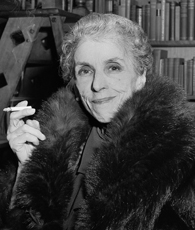Karen Blixen may be the best-known Danish writer of the 20th century, authoring books such as “Seven Gothic Tales,” “Winter’s Tales” and “Out of Africa” under the pen name Isak Dinesen.
Karen Blixen’s Early Days
Karen Christence Dinesen was born April 17, 1885, in Rungsted, Denmark, located about 25 miles north of Copenhagen.
As a child, she liked “to write fairy tales, stories and plays, the latter being performed at her home with her sisters and friends,” according to the Karen Blixen Museum in Rungsted. “The notebooks in which she wrote are also full of drawings of trolls and landscapes, portraits of women and illustrations of her favourite reading at the time.”
In 1913, she married her cousin, Swedish Baron Bror Blixen-Finecke, and soon moved with him to Kenya, where they ran a coffee plantation. Though she divorced the baron in 1921, she remained at the plantation for another 10 years until financial difficulties forced her to return to Denmark.
Sources in this Story
- Karen Blixen Museum (Denmark): Karen Blixen’s Life
- Encyclopedia Britannica: 300 Women Who Changed the World: Isak Dinesen
- University of Alberta: Canadian Institute for Nordic Studies: Stambaugh’s Public Lecture on Danish Writer Karen Blixen/Isak Dinesen
- The Paris Review: Isak Dinesen
Blixen’s Notable Accomplishments
With the financial downfall of her plantation, Blixen was broke and unsure of what to do with her life. She considered becoming a cook, but decided to become a serious writer instead; “I have begun to do what we brothers and sisters do when we don’t know what else to resort to,—I have started to write a book,” she wrote to her brother.
Writing in English, she wrote a collection of stories that was published in 1934 under the title “Seven Gothic Tales.” She also adopted a pen name: Isak (meaning “laughter” in Hebrew) Dinesen (her maiden name). The book became a hit in America, prompting her to write a Danish version and begin work on her memoirs of her time in Africa.
Her memoirs, written simultaneously in English and Danish, were completed in 1937 and published as “Out of Africa.” The book revealed “an almost mystical love of Africa and its people,” writes Encyclopedia Britannica. “The book is a poetic reminiscence of her triumphs and her sorrows on the loss of her farm, the death of her companion, the English hunter Denys Finch Hatton, and the disappearance of the simple African way of life she admired.”
“Out of Africa” would become Dinesen’s most successful and famous work, and would be made into an Oscar-winning film in 1985. Dinesen continued writing collections of old tales, including “Winter’s Tales” and “Last Tales.”
“I write about characters who together are the tale,” she told the Paris Review in a 1956 interview. “I begin, you see, with a flavor of the tale. Then I find the characters, and they take over. They make the design, I simply permit them their liberty.”
She wrote only one novel in her career, “The Angelic Avengers,” released under the pseudonym Pierre Andrezel. Blixen admitted that she wrote the book mostly for the money, telling the Paris Review that it was her “illegitimate child.”
The Rest of the Story
Blixen suffered through several health problems in her later life, which may have been brought on by syphilis she contracted during her first marriage or by the subsequent mercury treatment for the disease. She had surgery for a stomach ulcer in 1955, which severely restricted the amount of food she could consume.
Though she was “virtually an invalid for the rest of her life,” according to the Blixen Museum, she continued writing tales before her death in 1962 of undernourishment.











